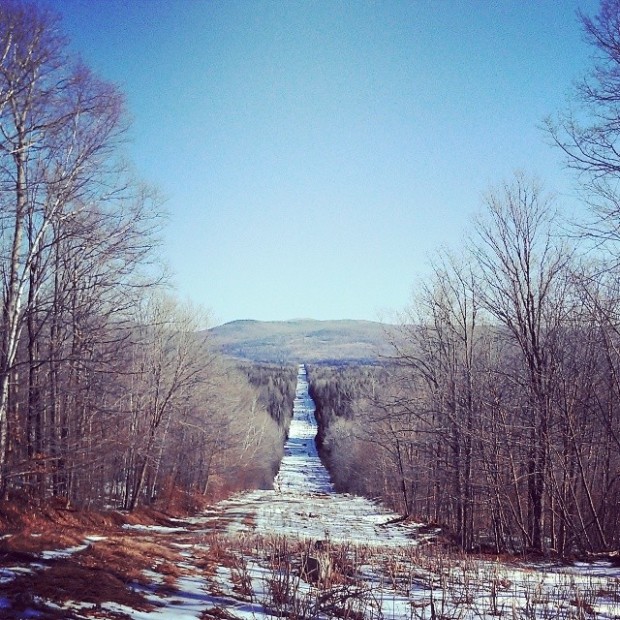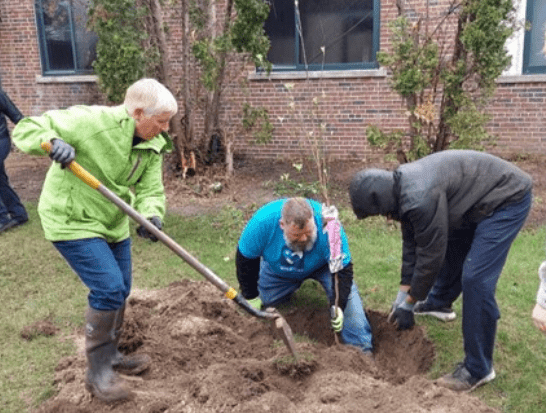We have much more to do and your continued support is needed now more than ever.
Portland-Montreal Pipeline Trek Day 2 – A View from Victory State Forest, VT
Guest Post by: Brett Chamberlin
The first day of our weeklong trek along the Portland-Montreal Pipeline was unseasonably warm, despite the persistent rain. In Northern Vermont, the few remaining patches of snow melted, evaporated, and settled upon the fields and foothills as a thick fog. We spent the day visiting a series of sites along the pipeline’s route, which passes under roads and rivers across the state.

Below this vibrant ecosystem and beneath three feet of soil still locked in permafrost are the three pipes which constitute the Portland-Montreal Pipeline. The original line, 12 inches in diameter, was completed in 1951 and decommissioned in 1982. Another line was added in 1950, and a third in 1965.
Although the pipes themselves are buried, their path cuts viciously through the land. The entire 236-mile route is clearcut of all vegetation to maintain about a 70-foot wide “right-of-way.” The clearcut path is now used by recreational snowmobile and ATV riders. It cuts across rivers, roads, and forests.
From the top of a hill in Victory State Forest, Vermont, we can see the right-of-way stretching far into the distance before us. The 15,000 state forest is home to black bears and over 130 species of birds. Some, like the gray jay and white-winged crossbill, live only in boreal forests like Victory.
The aging pipeline that pushes through this forest is indifferent to birds, bears and beavers. If it spills – when it spills – it is places like Victory State Forest that will be spilled upon.
Speak up for Northeast Wildlife
![]() Help protect moose from dirty fuels. Tell the State Department to stop the Northeast tar sands pipeline.
Help protect moose from dirty fuels. Tell the State Department to stop the Northeast tar sands pipeline.
About the authors
NWF Campus Ecology Fellow Kaity Thomson and her companion Brett Chamberlin are blogging their weeklong trek along the route of the Portland-Montreal Pipeline (by foot, cross country skis, snow shoes and a hybrid car!) to meet with community members and experience the habitats at risk of a spill. Kaity and Brett will also be live-tweeting their adventure—follow them on twitter at @99brett and @kaityt18, and join in on the conversation by using the hashtags: #PMPL or #PipeHike
 Brett Chamberlin is a recent graduate of New York University, where he studied politics and journalism. A NH native, Brett has organized a variety of viral projects around economic and environmental justice issues. His writing and activism have been appeared on NHPR, The Nation, BuzzFeed, The Village Voice, and more. Brett is now working as a founder of the Post-Landfill Action Network, a nonprofit helping students end waste on campus. He’s also an avid twitter user at @99Brett
Brett Chamberlin is a recent graduate of New York University, where he studied politics and journalism. A NH native, Brett has organized a variety of viral projects around economic and environmental justice issues. His writing and activism have been appeared on NHPR, The Nation, BuzzFeed, The Village Voice, and more. Brett is now working as a founder of the Post-Landfill Action Network, a nonprofit helping students end waste on campus. He’s also an avid twitter user at @99Brett
 Kaity Thomson is pursuing a BSc in Environmental Science at the University of New Hampshire. Initially leaving home to study dance in New York City, Kaity quickly came to realize the importance of the natural landscape she left behind. Transferring home to NH, she was driven to understand the environment and learn how to effectively communicate its importance. Currently, Kaity is researching potential impacts of a tar sands pipeline in New England. Her research and outreach is supported by the National Science Foundation and National Wildlife Federation Campus Ecology Fellowship.
Kaity Thomson is pursuing a BSc in Environmental Science at the University of New Hampshire. Initially leaving home to study dance in New York City, Kaity quickly came to realize the importance of the natural landscape she left behind. Transferring home to NH, she was driven to understand the environment and learn how to effectively communicate its importance. Currently, Kaity is researching potential impacts of a tar sands pipeline in New England. Her research and outreach is supported by the National Science Foundation and National Wildlife Federation Campus Ecology Fellowship.




















